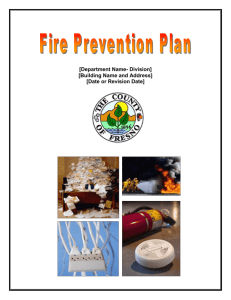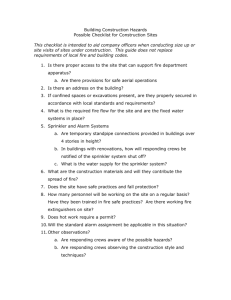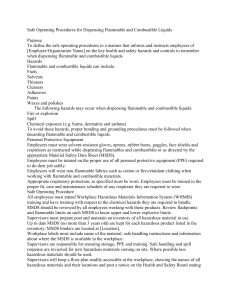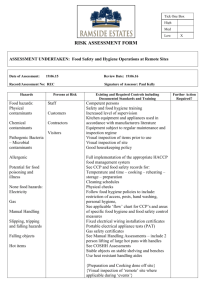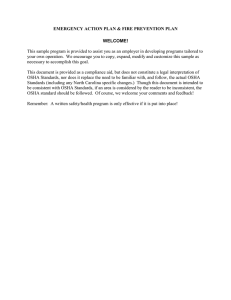Chabot College Fall 2003 Replaced Fall 2010
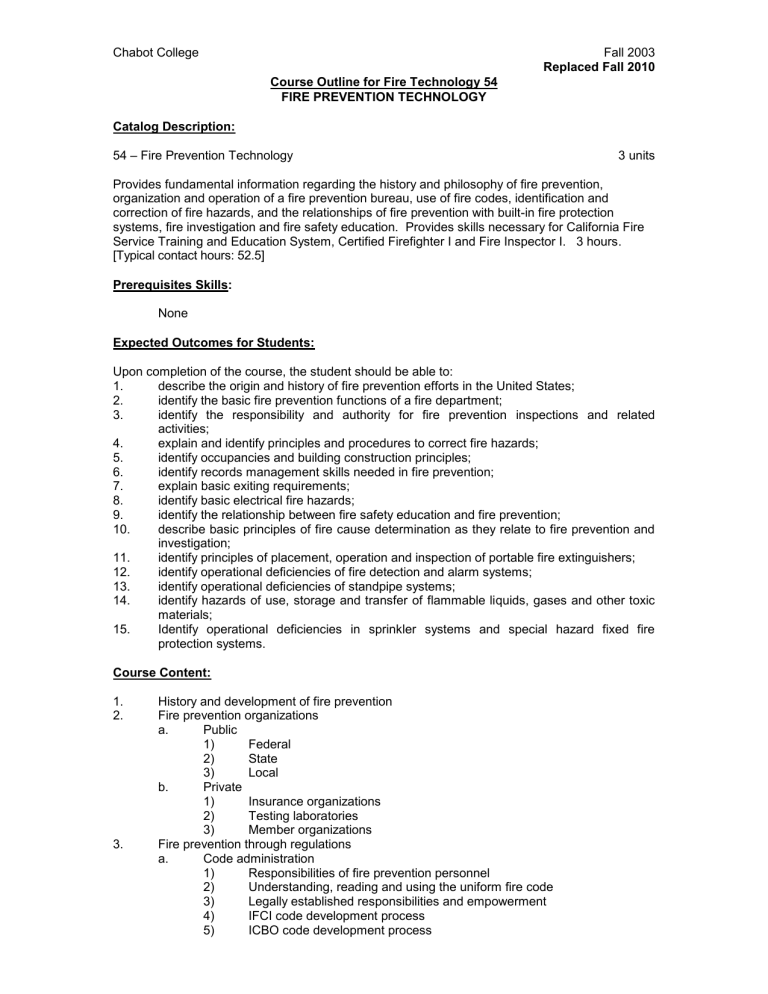
Chabot College Fall 2003
Replaced Fall 2010
Course Outline for Fire Technology 54
FIRE PREVENTION TECHNOLOGY
Catalog Description:
54 – Fire Prevention Technology
Provides fundamental information regarding the history and philosophy of fire prevention, organization and operation of a fire prevention bureau, use of fire codes, identification and correction of fire hazards, and the relationships of fire prevention with built-in fire protection
3 units systems, fire investigation and fire safety education. Provides skills necessary for California Fire
Service Training and Education System, Certified Firefighter I and Fire Inspector I. 3 hours.
[Typical contact hours: 52.5]
Prerequisites Skills:
None
Expected Outcomes for Students:
4.
5.
6.
7.
8.
9.
10.
Upon completion of the course, the student should be able to:
1.
2.
3. describe the origin and history of fire prevention efforts in the United States; identify the basic fire prevention functions of a fire department; identify the responsibility and authority for fire prevention inspections and related activities; explain and identify principles and procedures to correct fire hazards; identify occupancies and building construction principles; identify records management skills needed in fire prevention; explain basic exiting requirements; identify basic electrical fire hazards; identify the relationship between fire safety education and fire prevention; describe basic principles of fire cause determination as they relate to fire prevention and investigation; identify principles of placement, operation and inspection of portable fire extinguishers; 11.
12.
13.
14.
15. identify operational deficiencies of fire detection and alarm systems; identify operational deficiencies of standpipe systems; identify hazards of use, storage and transfer of flammable liquids, gases and other toxic materials;
Identify operational deficiencies in sprinkler systems and special hazard fixed fire protection systems.
Course Content:
1.
2.
History and development of fire prevention
Fire prevention organizations a. Public
3. b.
1)
2)
3)
Private
Federal
State
Local
1)
2)
Insurance organizations
Testing laboratories
3) Member organizations
Fire prevention through regulations a. Code administration
1) Responsibilities of fire prevention personnel
2)
3)
4)
5)
Understanding, reading and using the uniform fire code
Legally established responsibilities and empowerment
IFCI code development process
ICBO code development process
Chabot College
Course Outline for Fire Technology 54, page 2
Fall 2003
4. b. Inspection
1) Fire incident reporting awareness
2)
3)
Factors relating to life safety
General fire inspection practices
4)
5)
Procedure for correcting fire hazards and modification of requirements
Fire drills and emergency evacuation
6) Handling fire prevention complaints
Fire prevention through public education a. b.
Basic instruction techniques for public education
Teaching children about fire safety
5.
6.
7. c. d. e. f.
Teaching adults about fire safety
Teaching the public about fire safety issues
Teaching the public about fire and burn prevention
Juvenile firesetter awareness
General fire safety and electrical safety a. General fire safety b. c. d.
Basic electrical theory
Electrical fire hazards and safety devices
Reference sources related to electrical codes and safety d. e. f. g.
Building construction for fire prevention a. Classification of occupancies b. c.
Building construction classifications
Relationship of fire protection to building construction and occupancy
Types and classifications of roof coverings
Purpose and location of fire rated building construction
Fire doors and windows
Inspecting kitchen cooking equipment h. Fire safety requirements for decorative materials and furnishings
Exiting and life safety
8.
9.
10. h. i. j. k. d. e. f. g. l. m. a. b. c. d.
The life safety issue
Exit requirements
Determination of adequate Egress
Maintenance of exits e. Enclosed exit stairwells and smokeproof enclosures
High piled combustible stock
Fire protection equipment and systems a. Portable fire extinguishers b. c.
Distribution and location of portable fire extinguishers
Inspection of fire extinguishers
Features of fixed fire protection systems
Inspection of fixed fire protection systems
Inspection of kitchen cooking systems
Private water supply systems
Standpipe and hose systems
Inspection of standpipe systems
Types of fire sprinkler systems
Principles and features of sprinkler systems
Inspection of dry and wet pipe sprinkler systems
Conduct tests on dry and wet pipe sprinkler systems n. o. p. q.
Capabilities, limitations and design of sprinkler systems
Local fire alarm systems
Classification of fire alarm systems
Inspection of fire alarm systems r. s.
Features of fire alarm systems
Fire alarm panels and other equipment
Properties of hazardous materials a. Sources of technical information on hazardous materials b. c.
Basic classes of flammable and combustible liquids
Properties of flammable and combustible liquids
Chabot College
Course Outline for Fire Technology 54, page 3
Fall 2003 h. i. j. k. d. e. f. g. l. m.
Characteristics of common oxidizing materials and organic peroxides
Characteristics of common radioactive materials
Characteristics of common toxic materials
Characteristics of unstable (reactive) materials
Characteristics of combustible metals
Characteristics of combustible dust
Characteristics of corrosives
Classification of explosive
Technical information on explosive
Fire hazards of plastics
11.
12. n. D.O.T. regulatory labeling and placarding
Storage and use of hazardous materials a. Recommended practices and procedures for inside storage of flammable and combustible materials b. c. d. e.
Recommended practices and procedures for outside storage of flammable and combustible liquids
Acceptable containers for flammable and combustible liquids
Transferring flammable and combustible liquids, use, dispensing and mixing
Control of ignition sources and explosive atmospheres f. g. h. i.
Properties of compressed, cryogenic and liquefied gases
Fire hazards of compressed and liquefied gases
Storage and transfer practices of compressed and liquefied gases
Regulations for storage, handling, and use of natural and synthetic fibers j. k.
Describe hazards of explosives/fireworks and the need for security
Describe sources of technical information on explosive and fireworks
Fire investigation a. Determine cause and origin b. c.
Accidental fires
Arson fires
13.
14.
Plan review a. Building b. c.
Fire protection systems
Water supplies d. e.
Underground flammable liquid tanks
Life safety systems f. Residential subdivisions
Records and reports a. b.
Property loss, death and injury reports
Record keeping for inspection reports c. d. e.
Fire investigation reports
Computerized record keeping
Fire prevention bureau effectiveness reports
Methods of Presentation:
1.
2.
3.
4.
5.
Lecture
Visual aids
Group discussion and assignments
Case studies
Field trips
Typical Assignments and Methods of Evaluating Student Progress:
1. Typical Assignments a. b.
Essay explaining and identifying principles and procedures to correct fire hazards
Presentations by groups describing basic principles of fire cause determination
2.
Chabot College
Course Outline for Fire Technology 54, page 4
Fall 2003 c. Term paper
1) Explain the difference between spinkle and standpipe systems and
2) explain the operating principles of both
Create a fire prevention bureau for a large sized city (greater than
100,000 population); include an organizational chart with appropriate staff positions and responsibilities of each staff position
Methods of evaluating student progress a. b. c. d. e.
Computational and writing assignments
Performance in class projects
Field work in fire prevention inspections
Quizzes
Midterm and final examination
Textbook(s) (typical)
Fire Prevention, Inspection and Code Enforcement , Diamantes, D., Delmar Publisher, 1997
Student Manual, Fire Prevention IA , California Fire Service Training and Education System,
1996
Fire Inspection and Code Enforcement , International Fire Service Training Association, 6 th edition, 1998
Special Student Materials
None
Revised: 10/10/02
